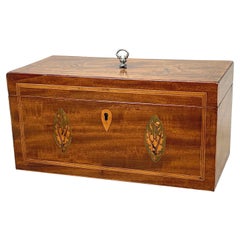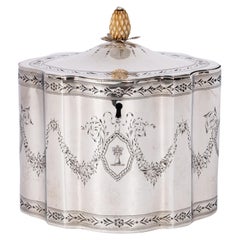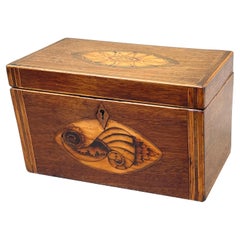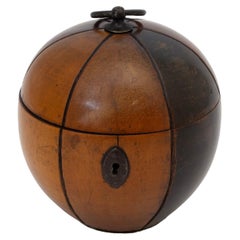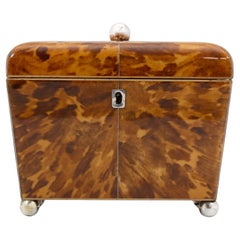Georgian Tea Caddies
to
8
110
1
76
32
2
1
1
1
111
76
59
12
10
6
5
3
3
2
2
1
1
1
1
84
44
40
23
21
78
29
105
96
82
1
1
Height
to
Width
to
111
111
111
2
1
1
1
1
Style: Georgian
Antique English Georgian Silver Tea Caddy by William Vincent
Located in Northampton, GB
Hallmarked Sterling by William Vincent of London Dated 1779
From our Tea Caddy collection, we are delighted to offer this Georgian Sterling Silver Tea Caddy. The Tea Caddy of slight...
Category
Late 18th Century English Antique Georgian Tea Caddies
Materials
Sterling Silver
Large Georgian Mahogany Tea Caddy
Located in Bedfordshire, GB
A good quality Georgian 18th century mahogany rectangular tea caddy having replacement brass axe drop handle to hinged lid enclosing cavity with attractive inlaid decoration throughout.
Tea was of course a very precious commodity throughout the 18th and 19th centuries and the purpose of a tea caddy was not just to preserve the and extend the life of the precious tea leaves...
Category
Late 18th Century English Antique Georgian Tea Caddies
Materials
Mahogany
Antique Georgian Locking Sterling Silver Tea Caddy Henry Chawner London 1787
Located in Portland, OR
A fine antique Georgian engraved sterling silver tea caddy, by Henry Chawner, London, 1787.
Of fluted oval form with bright-cut floral borders with ...
Category
1780s English Antique Georgian Tea Caddies
Materials
Silver
Georgian 18th Century Mahogany Tea Caddy
Located in Bedfordshire, GB
A Late 18th century Georgian Period Mahogany Oblong tea caddy having very attractive inlaid decoration to front and hinged top enclosing double lidded interior with original paper foil landing.
This particular caddy is relatively plain and simple in design, but is lifted significantly with the attractive inlaid decoration.
It remains in relatively good condition and had clearly been well loved throughout its life.
Tea was a precious commodity throughout the 18th and 19th centuries and the purpose of a tea caddy was not just to preserve the and extend the life of the precious tea leaves, but also to enable the owner to lock away those aforementioned valuable tea leaves, keeping them safe from the house staffs potential wandering hands.
This 18th century tea caddy...
Category
Late 18th Century English Antique Georgian Tea Caddies
Materials
Mahogany
Antique Continental Melon Fruit Novelty Tea Caddy
Located in Northampton, GB
Round Shape with Ring Handle
From our Tea Caddy collection, we are delighted off this Antique Continental Melon Fruit Tea Caddy. The Tea Caddy made from Sycamore and of novelty form...
Category
Early 1800s European Antique Georgian Tea Caddies
Materials
Steel
Antique English Georgian Blonde Tortoiseshell Tea Caddy
Located in Northampton, GB
Faced In Boxwood
From our Tea Caddy collection, we are thrilled to offer this Antique Blonde Tortoiseshell Tea Caddy. The Tea Chest of tapered rectangular shape with silver stringin...
Category
Early 1800s English Antique Georgian Tea Caddies
Materials
Silver Plate
Georgian Mahogany 18th Century Tea Caddy, circa 1780
Located in Incline Village, NV
Nice mellow patina on this 18th century English mahogany tea caddy with three interior compartments. Two end sections have incised geometric carved lids. Tapered all around from top ...
Category
1780s English Antique Georgian Tea Caddies
Materials
Wood
Period Georgian Tea Caddy, Circa 1790-1810
Located in High Point, NC
Circa 1790-1810 period Georgian tea caddy made from Mahogany. The tea caddy has been used well and loved over many centuries. The top has a brass ring with which to lift the lid. ...
Category
Late 18th Century English Antique Georgian Tea Caddies
Materials
Mahogany, Satinwood
18th Century Sterling Silver Locking Tea Caddy
By Michael Plummer
Located in Jesmond, Newcastle Upon Tyne
An exceptional, fine and impressive antique Georgian English sterling silver locking tea caddy; an addition to our silver teaware collection.
This exceptional antique George III sterling silver locking tea caddy has a navette, paneled shaped form.
The body of this silver tea caddy box is embellished with bands of bright cut engraved volute spiraling leaf ornamentation on a matte background to the upper and lower portions; these bands flank a plain undulating bordered panel.
The ornamentation to the surface of the caddy alternates with panels of concave vertical fluted decoration.
This antique Georgian tea caddy is retains the original hallmarked flush hinged covers; the flush hinge indicates the fine quality of this piece.
The cover is embellished with further bright cut engraved undulating borders accented with bud motifs, in addition to simplified borders paralleling the domed paneled portion; the domed portions reflects the incurved shape of the body.
This impressive cover is surmounted with a cast sterling silver urn style finial, in the Classic Adams style.
The caddy retains the original fitted fully working lock and functional key.
This sterling silver tea caddy is a highly desirable shape and style.
Condition:
This Georgian silver tea caddy...
Category
1790s English Antique Georgian Tea Caddies
Materials
Silver, Sterling Silver
English Inlaid Mahogany Tea Caddy with Elaborate Crossbanding and Swag Inlay
Located in San Francisco, CA
An extremely fine quality inlaid mahogany tea caddy of elegant small size, the top and front with elaborate crossbanding and circular fan inay, the front with further swag inlay, the...
Category
Late 18th Century English Antique Georgian Tea Caddies
Materials
Boxwood, Mahogany, Rosewood
Antique Georgian Sterling Silver Locking Tea Caddy
Located in Jesmond, Newcastle Upon Tyne
An exceptional, fine and impressive antique Georgian English sterling silver locking tea caddy; an addition to our silver teaware collection
This exceptional antique Georgian sterling silver tea caddy has a cylindrical form.
The upper and lower portions of this Aesthetic style silver tea caddy is embellished with bands of bright cut engraved floral bud designs; further vertical bands segment the body into five equal portions, each encompassed with undulating wrigglework borders.
The anterior portion of the body is ornamented with a bright cut engraved rectangular cut cornered cartouche encompassed with a radiating simplified floral and scrolling foliate decoration and featuring the contemporary engraved crest of a lion's head collared and erased.
The further four segments bear Chinoiserie bright cut engraved Chinese symbols representing the four seasons: spring (? / chun), summer (? / xia), autumn (? / qiu) and winter (? / dong).
This antique silver tea caddy retains the original hallmarked flush hinged cover; the flush hinge indicates the fine quality of this piece.
The cover is encompassed with further bands of bright cut engraved decoration, reflecting the designs to the body.
This impressive cover is surmounted with the original, exceptional carved wood and sterling silver pineapple...
Category
1780s British Antique Georgian Tea Caddies
Materials
Silver, Sterling Silver
English Antique Georgian Henry Clay Papier Mache Tea Caddy
By Henry Clay
Located in Northampton, GB
Featuring Countryside Scenes
From our Tea Caddy collection, we are delighted to introduce to the market this Papier Mache Tea Caddy by Henry Clay. The Henry Clay Tea Caddy of oval ...
Category
Early 1800s English Antique Georgian Tea Caddies
Materials
Paper
18th Century Walnut Tea Caddy
Located in Bedfordshire, GB
An Attractive Early 18th Century George II Period Walnut Tea Caddy Of Rectangular Form, Having Crossbanded And Inlaid Decoration To Top Enclosing Three Divisions, With Original Brass...
Category
Early 18th Century English Antique Georgian Tea Caddies
Materials
Walnut
George III Period Mahogany Tea Caddy
Located in Bedfordshire, GB
A Very Good Quality 18th century, Georgian Mahogany Rectangular Tea Caddy, Having Original Brass Handle To Hinged Top, Enclosing Divisions, With Unusual Glazed Panels To Front Bearin...
Category
Mid-18th Century English Antique Georgian Tea Caddies
Materials
Mahogany
Georgian Style Burton-Ching burl Walnut Regency Tea Caddy
Located in LOS ANGELES, CA
Georgian Style Burton-Ching burl Walnut Regency Tea Caddy
Category
21st Century and Contemporary American Georgian Tea Caddies
Materials
Walnut
George II Period Mahogany Tea Caddy
Located in Bedfordshire, GB
An 18th Century, George II Period, Mahogany Rectangular Tea Caddy Having Original Brass Swan Neck Handle To Hinged Top, Enclosing Three Interior Divisions And Elegant Canted Corners,...
Category
Early 18th Century English Antique Georgian Tea Caddies
Materials
Mahogany
18th Century Mahogany Tea Caddy
Located in Bedfordshire, GB
A late 18th century, Georgian, Mahogany tea caddy having extremely attractive inlaid conch shells, banded and strung decoration, with hinged lid enclosing lidded interior retaining partial paper foil lining.
This particular caddy is relatively plain and simple in design, but the attractive inlaid decoration lifts it significantly.
The condition remains relatively good and clearly it has been well loved throughout its life.
Tea was a precious commodity throughout the 18th and 19th centuries and the purpose of a tea caddy was not just to preserve the and extend the life of the precious tea leaves, but also to enable the owner to lock away those aforementioned valuable tea leaves, keeping them safe from the house staffs potential wandering hands.
This 18th century tea caddy...
Category
Late 18th Century English Antique Georgian Tea Caddies
Materials
Mahogany
Antique Irish Georgian Hand Cut Crystal Sterling Silver Tea Caddy George III
Located in Dublin, Ireland
An exceptionally rare Irish George III hand cut full lead crystal single tea caddy of rectangular outline with canted corners and outstanding quality, first quarter of the nineteenth century.
The finely chased silver mounted rim and hinged cover, hand cut with three bands of lozenges on a plain ground, decorative star cut base underneath.
Condition: Exceptional condition for such an early piece, with no losses or clouding inside, silver mounts are unmarked but test positive for silver. Wonderful age wear underneath on base. Lock is present but key does not turn. Back and front views are similar.
Measures: Height: 5.25” (13.5cm). Width: 3.75” (9.5cm). Depth: 3” (7.5cm).
Location: Dublin City, Ireland.
Stunning and rare Tea Caddy...
Category
18th Century Irish Antique Georgian Tea Caddies
Materials
Crystal, Sterling Silver
Georgian Rosewood Oblong Tea Caddy
Located in Bedfordshire, GB
A very attractive, good quality, late 18th century rosewood oblong shaped tea caddy having satinwood strung mouldings and original brass hinges, with working lock and key.
Constructed using attractive rosewood timber which retains a good colour and patina, the satinwood strung mouldings used on this tea caddy create a really nice contrast.
Tea was a precious commodity throughout the 18th and 19th centuries and the purpose of a tea caddy was not just to preserve the and extend the life of the precious tea leaves...
Category
Late 18th Century English Antique Georgian Tea Caddies
Materials
Rosewood
Antique George III Sterling Silver Locking Tea Caddy
Located in Jesmond, Newcastle Upon Tyne
An exceptional, fine and impressive antique Georgian English sterling silver locking tea caddy; an addition to our silver teaware collection.
This exceptional antique Georgian sterling silver tea caddy has an oval form.
The surface of the tea caddy is plain and unembellished, with an applied reed decorated border to the upper and lower rims.
This antique silver tea caddy retains the original hallmarked domed flush hinged cover; the flush hinge indicates the fine quality of this piece.
The cover is surmounted with the original and exceptional silver topped oval button style finial.
This antique Georgian tea caddy...
Category
1790s British Antique Georgian Tea Caddies
Materials
Sterling Silver
Exceptional Georgian Crossbanded Satinwood Tea Caddy w/ Oval Inlaid Shell Panels
Located in Chapel Hill, NC
A fine tea chest or tea caddy in satinwood with crossbanded edges on the lid and all four sides, the lid, front and sides inlaid with ovals of tortoiseshell. The lid, centered with a...
Category
Late 18th Century English Antique Georgian Tea Caddies
Materials
Satinwood
Georgian Novelty Apple Tea Caddy
Located in Northampton, GB
Shaped as an Apple
From our Tea Caddy collection, we are delighted to offer this superb Georgian Apple Treen Tea Caddy. The Tea Caddy carved from Treen as a novelty Apple with a button stalk, shaped body and shaped cut steel escutcheon. When opened the Caddy reveals traces of the original tin foil lining for housing Tea leaves. The Apple Fruit Tea Caddy...
Category
Early 1800s European Antique Georgian Tea Caddies
Materials
Wood
Mid-18th Century George II Period Tea Chest, Manner of Abraham Roentgen
Located in Richmond, London
This extremely rare tea-chest is a fine example of the mid-18th century fashion for brass-inlaid furniture and boxes, and undoubtedly originates from the circle of outstanding crafts...
Category
Mid-18th Century English Antique Georgian Tea Caddies
Materials
Brass
Georgian Tortoiseshell Tea Caddy
Located in Northampton, GB
Oval Tea Caddy with Silver Mounts
From our Tea Caddy collection, we are delighted to offer this Georgian Silver and Tortoiseshell Tea Caddy. The Tea Caddy is of oval shape with a Tortoiseshell exterior mounted with engraved silver stringing, a silver shield plaque below the silver escutcheon and a silver looped handle. The interior features a floating tea shelf...
Category
Early 1800s English Antique Georgian Tea Caddies
Materials
Silver
$7,024 Sale Price
20% Off
18th Century Padouk Wood Tea Caddy
Located in Bedfordshire, GB
A Very Rare 18th Century Padouk Wood Rectangular Tea Caddy Of Rectangular Form, Having Original Brass Handle To Hinged Top Enclosing Divisions, Raised On Elegant Original Brass Claw ...
Category
Mid-18th Century English Antique Georgian Tea Caddies
Materials
Padouk
Geometrically Inlaid Georgian Rosewood Two Chamber Tea Caddy w/Sugar Bowl
Located in Chapel Hill, NC
Fine George III rosewood double chamber tea caddy with classical inspired geometric inlay of exotic woods including satinwood, mahogany, kingwood and palm. The rectangular case with ...
Category
Late 18th Century English Antique Georgian Tea Caddies
Materials
Brass
Georgian Novelty Apple Fruit Tea Caddy
Located in Northampton, GB
Shaped as an Apple
From our Tea Caddy collection, we are delighted to offer this superb Georgian Apple Treen Tea Caddy. The Tea Caddy carved from Sycamore as a novelty Apple with a button stalk, shaped body and shaped cut steel escutcheon. When opened the Caddy reveals traces of the original tin foil lining for housing Tea leaves. The Apple Fruit Tea Caddy...
Category
Early 1800s English Antique Georgian Tea Caddies
Materials
Sycamore
Small Antique Sarcophagus Shaped Tea Caddy . English C.1830
Located in St Annes, Lancashire
A lovely Georgian tea caddy.
Tropical hardwood with boxwood stringing detail
Two compartments internally with lids
Free UK shipping
Category
1820s English Antique Georgian Tea Caddies
Materials
Wood
Antique Belgian Spa Tea Caddy
Located in Northampton, GB
Depicting Various Spa Scenes
From our Tea Caddy collection, we are delighted to introduce this superb Belgian Spa Tea Caddy. The Tea Caddy of square form made from Sycamore is beaut...
Category
Late 18th Century Belgian Antique Georgian Tea Caddies
Materials
Sycamore
Antique English Georgian Style Inlaid Mahogany Bombe Shaped Tea Caddy
Located in Philadelphia, PA
A fine antique Georgian style mahogany tea caddy.
Of bombé form with fruit wood inlay, gilt brass mounts & handle, and bracket feet.
Simply a wonderful, rare form!
Date:
L...
Category
Early 20th Century English Georgian Tea Caddies
Materials
Brass
Antique English Georgian Hexagonal Satinwood Tea Caddy
Located in Northampton, GB
Kingwood Inlay
From our Tea Caddy collection, we are delighted to offer this Elongated Hexagonal Satinwood Tea Caddy. The Tea Caddy of stretched hexagonal shape with six matching pa...
Category
Late 18th Century English Antique Georgian Tea Caddies
Materials
Silver Plate
Very Good Georgian Burr Elm Sarcophagus Shaped Tea Caddy, U.K, circa 1800
Located in Ottawa, Ontario
A very handsome early 19th century Georgian sarcophagus-shaped tea caddy in burr elm. The highly figured case fitted with a hinged canted top with a cross-banded edge, opening to an interior housing twin lidded tea canisters flanking a period cut-glass mixing bowl...
Category
Early 19th Century British Antique Georgian Tea Caddies
Materials
Elm, Cut Glass
Georgian Satinwood Tea Chest with Secret Compartments
Located in Northampton, GB
Georgian Tea Chest with Boxwood & Ebony Checkered Stringing
From our Tea Caddy collection, we are delighted to offer this Rare Georgian Satinwood Tea Chest. The Tea Chest of rectang...
Category
Late 18th Century British Antique Georgian Tea Caddies
Materials
Silver
Georgian 18th Century Mahogany Tea Caddy
Located in Bedfordshire, GB
A Very Good Quality 18th century Georgian, Chippendale Period, Mahogany Tea Caddy Of Rectangular Form, Having Elegant Shaped Top Enclosing Original Tin Containers, Retaining Original...
Category
Mid-18th Century English Antique Georgian Tea Caddies
Materials
Mahogany
Antique Georgian Masonic Freemasons Tea Caddy
Located in Northampton, GB
Featuring Masonic Scenes
From our Tea Caddy collection, we are delighted to offer this extremely rare Georgian Masonic Tea caddy. The Tea Caddy of box form with chequered edging and borders of Tulipwood surrounding Burr Yew wood squares each featuring Satinwood oval panels depicting Masonic Symbols. The symbols include the past master, senior warden, junior warden and the past worshipful master. The top of the box features inlaid moon, stars and sun surmounted by a brass carry handle. The interior of the Tea Caddy features a floating lid with a turned metal handle. The Tea Caddy dates to the Georgian period during the reign of George III circa 1800.
The Tea Caddy comes complete with working lock and tasselled key.
Tulipwood is also known as Brazilian Tulipwood, Brazilian Pinkwood and Bahia Rosewood. It is found in South America, mainly Brazil. The colour is a warm yellow with streaks or brown-red grain.
Burr Yew originates from Asia, Europe and North Africa. It is yellow-brown to orange-brown and usually conforms to a fine uniform pattern. Yew wood usually has black pips scattered throughout so clean veneers fetch a high price and are reserved for finer items. A few trees will produce a burr which offers a distinct decorative finish.
Satinwood is found in India and Sri Lanka. It has a rich golden colour and an almost reflective sheen. Satinwood is traditionally used for high quality furniture.
Georgian, a period in British history dating from 1714-1837, the Georgian era after the Hanoverian kings George I, George II, George III and George IV.
Masonic (Freemasons, Freemasonry or Masonry) refers to fraternal organisations that trace their origins to the local guilds of stonemasons that from the end of the 14th century regulated the qualifications of stonemasons and their interaction with authorities and clients. While Freemasonry is not itself a religion, all its members believe in a supreme being...
Category
Early 1800s English Antique Georgian Tea Caddies
Materials
Satinwood, Tulipwood, Yew
George III Burr Yew Tea Chest
Located in Northampton, GB
Lined with Red Velvet Circa 1790
From our Tea Caddy collection, we are pleased to offer this Georgian Burr Yew Wood Tea Chest. The Tea Chest of rectangular form featuring quadrant B...
Category
Late 18th Century English Antique Georgian Tea Caddies
Materials
Cut Glass, Yew
Georgian Octagonal Partridgewood Tea Caddy
Located in Bedfordshire, GB
A Rare Partridgewood, Late 18th Century Georgian Tea Caddy, Of Octagonal Form Having Attractive Inlaid Decoration And Hinged Lid Enclosing Two Lidded Divisions.
Partridge wood is a...
Category
Late 18th Century English Antique Georgian Tea Caddies
Materials
Other
Antique Georgian Paper Scroll Tea Caddy
Located in Northampton, GB
Framed In Boxwood
From our Tea Caddy collection, we are delighted to offer this exceptional Georgian Paper Scroll Tea Caddy. The Tea Caddy of e...
Category
Late 18th Century English Antique Georgian Tea Caddies
Materials
Glass, Boxwood, Paper
Antique George IV Gonçalo Alves & Amboyna Marquetry Tea Caddy C1825 19th Century
Located in London, GB
This is an exquisite antique George IV Gonçalo Alves and amboyna marquetry inlaid tea caddy, circa 1825 in date.
It is beautifully decorated with superb marquetry decoration to the ...
Category
1820s Antique Georgian Tea Caddies
Materials
Amboyna
George III Mahogany Tea Caddy with Inlay & Burled Crossbanding
Located in Atlanta, GA
George III Mahogany Tea Caddy with Inlay & Burled Crossbanding, ca. 1790
Category
Late 18th Century English Antique Georgian Tea Caddies
Materials
Mahogany
Georgian Mahogany & Inlaid Tea Caddy
Located in Bedfordshire, GB
A very attractive and good quality late 18th century Georgian mahogany oblong tea caddy, retaining good colour and patina, having attractive inlaid decoration to front and hinged lid, enclosing double sectioned interior with lids.
Tea was a precious commodity throughout the 18th and 19th centuries and the purpose of a tea caddy was not just to preserve the and extend the life of the precious tea leaves...
Category
Late 18th Century English Antique Georgian Tea Caddies
Materials
Mahogany
Antique George III Green Tortoiseshell Tea Caddy
Located in Northampton, GB
Georgian Period Circa 1790
From our Tea Caddy collection, we are delighted to offer this Georgian Green Tortoiseshell Tea Caddy. The Tea...
Category
Late 18th Century English Antique Georgian Tea Caddies
Materials
Silver
Antique 18c/19c English or French Enamel Bronze Mounted Tea Caddy Box
Located in Philadelphia, PA
A fine antique enamel tea caddy.
With a gilt bronze mounted lid.
In the South Staffordshire manner.
Decorated with floral sprays and rocaille swags to all sides.
Likely...
Category
Early 19th Century French Antique Georgian Tea Caddies
Materials
Bronze, Enamel
Georgian Original Painted Sycamore Tea Caddy
Located in Northampton, GB
George III Circa 1785
From our Tea Caddy collection, we are delighted to offer this Rare Original Hand-Painted Sycamore Tea Caddy. The Tea Caddy of Octagonal form veneered in Sycamo...
Category
Late 18th Century Antique Georgian Tea Caddies
Materials
Sycamore
Georgian Ribbed Bucket Tea Caddy
Located in Northampton, GB
Rare and unusual George III tea caddy in the form of a ribbed bucket.
The tea caddy of beautiful shape with a ribbed exterior carved from alternating panels of plain Sycamore and...
Category
Late 18th Century British Antique Georgian Tea Caddies
Materials
Cut Steel
Scottish Mauchline Ware Tea Caddy Attributed to Smiths
Located in Northampton, GB
Acorn Design
From our Tea Caddy collection, we are pleased to offer this Scottish Mauchline Ware Tea Caddy attributed to Smiths. The Mauchline Ware Tea Caddy of rectangular form ma...
Category
Early 19th Century Scottish Antique Georgian Tea Caddies
Materials
Sycamore
20th Century Sterling Italian Silver Tea Caddy George III replica
Located in VALENZA, IT
George III tea caddy replica.
Obtained from a silver sheet, it is rectangular in shape with shaped sides, it is embossed and chiseled with floral motifs and shells. The feet reprodu...
Category
Late 20th Century Italian Georgian Tea Caddies
Materials
Sterling Silver
Antique George III Harewood Inlaid Tea Chest
Located in Northampton, GB
With Two Tea Caddies
From our Tea Caddy collection, we are pleased to offer this Georgian Harewood Tea Chest. The Tea Chest of rectangular form veneered in Harewood with inlaid Boxw...
Category
Late 18th Century English Antique Georgian Tea Caddies
Materials
Boxwood, Harewood
Antique English George III Satinwood Tea Caddy
Located in Northampton, GB
With Conch Shell Inlay
From our Tea Caddy Collection, we are pleased to offer this superb Georgian Satinwood Tea Caddy. The Tea Caddy of rectangula...
Category
18th Century English Antique Georgian Tea Caddies
Materials
Boxwood, Satinwood, Tulipwood
Circa 1790 English George III Period Tea Caddy Box
Located in Chapel Hill, NC
Circa 1790 George III period tea caddy box, English. Original inlaid inner caddies & a later cut glass sugar well. Old Sheffield plate silver pull. Banded in box or holly. Classic re...
Category
1790s English Antique Georgian Tea Caddies
Materials
Sheffield Plate
Georgian Oval Tea Caddy
Located in Northampton, GB
From our Tea Caddy collection, we are delighted to offer this Georgian Oval Tea Caddy. The Tea Caddy of elongated Oval form veneered in Harewood with Box...
Category
Late 18th Century British Antique Georgian Tea Caddies
Materials
Brass
$5,217
Antique 18th Century Georgian Mahoghany Paper Scroll Work Tea Caddy Box 1780
Located in Portland, OR
A good antique Georgian scrollwork tea caddy, circa 1780.
The caddy of hexagonal shape, the front, back & cover with overall decoration of paper s...
Category
1780s English Antique Georgian Tea Caddies
Materials
Ivory, Mahogany, Satinwood, Paper
Antique English George III Inlaid Tea Caddy
Located in Northampton, GB
From our Tea Caddy collection, we are pleased to offer this Georgian octagonal Inlaid Tea Caddy. The Tea Caddy of octagonal form veneered in Harewood with inlaid twin Tuscan Columns ...
Category
Late 18th Century English Antique Georgian Tea Caddies
Materials
Boxwood
Antique English George III Tuscan Column Tea Caddy
Located in Northampton, GB
With Tuscan Columns & Fan Inlay.
From our Tea Caddy collection, we are pleased to offer this Georgian Harewood Tea Caddy. The Tea Caddy of octagonal shape with a Harewood veneer exterior and crossbanded Tulipwood with Boxwood edging. The front features an oval cartouche with a central fan inlay matching the lid with a further fan inlay surmounted by turned bone...
Category
Late 18th Century British Antique Georgian Tea Caddies
Materials
Boxwood
Antique George III quality mahogany tea caddy
Located in Ipswich, GB
Antique George III quality mahogany tea caddy having a quality antique George III mahogany and satinwood inlaid stringing tea caddy with a lift up lid opening to reveal the original ...
Category
19th Century Antique Georgian Tea Caddies
Materials
Mahogany
Georgian Octagonal Inlaid Tea Caddy
Located in Greenwich, CT
Fine George III octagonal tea caddy inlaid with various woods on a harewood ground, the central panels veneered with coucous wood and banded by holly stringing around a kingwood band, vines and berried...
Category
1780s English Antique Georgian Tea Caddies
Materials
Ebony, Kingwood, Harewood, Holly, Burl
18th Century George III Bombe Tea Caddy
Located in Richmond, London
A superb mid-18th century George III period bombe tea caddy. English, circa 1760.
Why we like it
A totally original example complete with tin caniste...
Category
Mid-18th Century English Antique Georgian Tea Caddies
Materials
Brass
Georgian Burr Yew Tea Caddy
Located in Northampton, GB
Burr Yew Inlaid Tea Caddy Circa 1780
From our Tea Caddies collection, we are thrilled to offer this square Georgian Burr Yew wood inlaid Tea Caddy. The Caddy of square form with c...
Category
Late 18th Century English Antique Georgian Tea Caddies
Materials
Boxwood, Yew
Circa 1790 English George III Inlaid Single Tea Caddy Box
Located in Chapel Hill, NC
Circa 1790 George III inlaid single tea caddy box, English. Desirable small form of satinwood with sycamore, holly & boxwood. Lid with fan medallion inlay, Dutch drop handle, & cross...
Category
1790s English Antique Georgian Tea Caddies
Materials
Wood
English Georgian Chinroserie Tortoise Shell Tea Caddy with Ball Feet, C. 1800
Located in Charleston, SC
English Georgian Chinroserie bow front tortoise shell tea caddy with a hinged tiered lid, Chinese landscape mother of pearl inlays with flanking pagodas, fences, & foliage trees, central paktong plaque and escutcheon, bone fitted interior border with two lidded tortoiseshell foil lined compartments, and resting on the original four bone ball...
Category
Early 1800s English Antique Georgian Tea Caddies
Materials
Foil
Georgian tea caddies for sale on 1stDibs.
Find a broad range of unique Georgian tea caddies for sale on 1stDibs. Many of these items were first offered in the Mid-20th Century, but contemporary artisans have continued to produce works inspired by this style. If you’re looking to add vintage tea caddies created in this style to your space, the works available on 1stDibs include decorative objects, serveware, ceramics, silver and glass and other home furnishings, frequently crafted with wood, mahogany and other materials. If you’re shopping for used Georgian tea caddies made in a specific country, there are Europe, United Kingdom, and England pieces for sale on 1stDibs. It’s true that these talented designers have at times inspired knockoffs, but our experienced specialists have partnered with only top vetted sellers to offer authentic pieces that come with a buyer protection guarantee. Prices for tea caddies differ depending upon multiple factors, including designer, materials, construction methods, condition and provenance. On 1stDibs, the price for these items starts at $235 and tops out at $25,243 while the average work can sell for $1,899.
Recently Viewed
View AllMore Ways To Browse
Bombe Tea Caddy
Chinese Pewter Tea Caddy
Fruit Tea Caddy
Monkey Teapot
Tortoiseshell Box 18th Century
Japanese Canister
Pewter Canister
Wooden Canister
Antique Coffee Bean Dispenser
Antique Weaving Machine
Boulle Tea Caddy
Chinese Tea Chest
Repousse Silver Tea Caddy
Tea Lock Box
Antique Apple Tea Caddy
Antique Mauchline Ware
Antique Tartan Ware
Apple Tea Caddy

